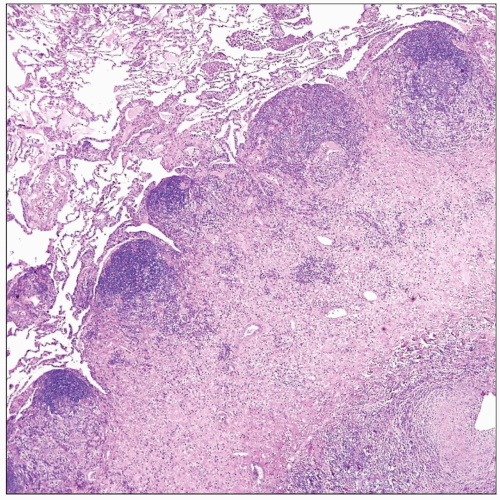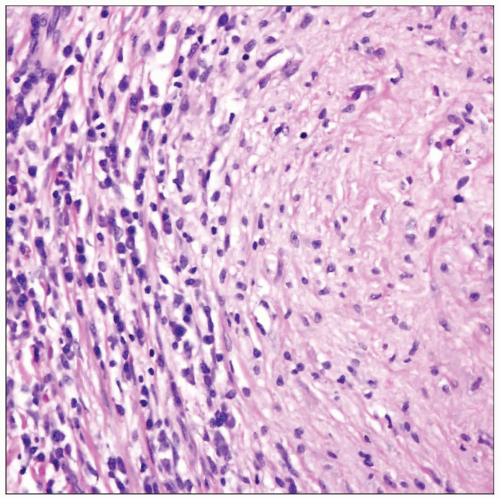IgG4 Sclerosing Lung Disease
Key Facts
Terminology
Systemic disease of unknown etiology characterized by elevated production of IgG4(+) plasma cells and tissue stromal sclerosis
Clinical Issues
Slowly progressive disease with involvement of multiple sites over a period of years with elevation of serum titers of IgG4
Most commonly involved sites include pancreas, hepatobiliary tract, salivary gland, orbit, and lymph nodes
Microscopic Pathology
3 histologic patterns of involvement are recognized in lung: Inflammatory pseudotumor-like, bronchovascular, and interstitial fibrosis-like
Inflammatory infiltrate is composed of small lymphocytes and mature plasma cells admixed with stromal fibrosis
Eosinophils are commonly present accompanying inflammatory infiltrates
Lymphoid follicles may be present in 50% of cases
Prominent vascular component characterized by endothelialitis of veins and arteries with narrowing and obliteration of vascular lumen
Ancillary Tests
Increased number of IgG4(+) plasma cells in tissue sections (> 50 per 10 HPF, with IgG4/IgG ratio of > 40%)
Raised serum level of IgG4 (> 135 mg/dL) is commonly seen but is not essential for diagnosis
 IgG4 sclerosing lung disease shows a nodular, well-circumscribed area of lung parenchyma with prominent stromal sclerosis and reactive lymphoid follicles in the periphery. |
TERMINOLOGY
Definitions
Systemic disease of unknown etiology characterized by elevated production of IgG4(+) plasma cells and tissue stromal sclerosis
ETIOLOGY/PATHOGENESIS
Pathogenesis
Unknown, but an autoimmune mechanism or hypersensitivity reaction has been postulated
Circulating autoantibodies are present in many patients
May be associated with other autoimmune disorders, e.g., Sjögren syndrome
CLINICAL ISSUES
Epidemiology
Age
Middle-aged and elderly patients
Gender
Male predominance
Presentation
Asymptomatic incidental finding in chest x-ray
Cough
Hemoptysis
Dyspnea
Pleural effusion
Natural History
Slowly progressive disease with involvement of multiple sites over a period of years with elevation of serum titers of IgG4
Most commonly involved sites include pancreas, hepatobiliary tract, salivary gland, orbit, and lymph nodes
Prototype of disease is so-called autoimmune pancreatitis
May involve almost any other organ site in body
Benign clinical course with good response to steroids
Some cases may evolve to malignant lymphoma or may be associated with development of carcinoma
Prognosis
Excellent response to steroid therapy
MICROSCOPIC PATHOLOGY
Histologic Features
3 histologic patterns of involvement are recognized in lung
Inflammatory pseudotumor-like
Solid, nodular growth pattern characterized by well-circumscribed area of sclerosis admixed with lymphocytes and plasma cells
Lesions closely resemble “inflammatory myofibroblastic tumor” and “inflammatory pseudotumor” of lung
Fibrosis is mostly paucicellular, with few myofibroblasts
Bronchovascular pattern of involvement
Stay updated, free articles. Join our Telegram channel

Full access? Get Clinical Tree



